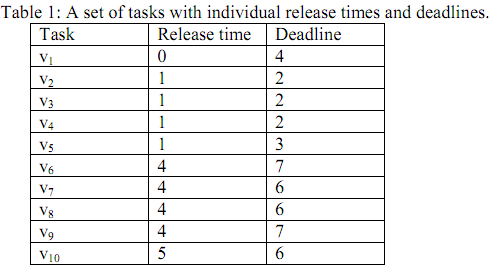An embedded system is a computer system performing dedicated functions within a larger mechanical or electrical system. Embedded systems range from portable devices such as Google Glasses, to large stationary installations like traffic lights, factory controllers, and complex systems like hybrid vehicles, and avionic. Typically, the software of an embedded system consists of a set of tasks (threads) with timing constraints. Typical timing constraints are release times and deadlines. A release time specifies the earliest time a task can start, and a deadline is the latest time by which a task needs to finish. One major goal of embedded system design is to find a schedule for the task set such that all the timing constraints are satisfied.
Task scheduler
We assume that the hardware platform of the target embedded systems is a single processor with midentical cores. The task set V={v1, v2, ..., vn} consists of n independent tasks. The execution time of each task is one time unit. Each task vi (i=1, 2, ,,, n) has a release time ri and a deadline di. All the release times and deadlines are non-negative integers. You need to design an algorithm for the task scheduler and implement it in Java. Your task scheduler uses EDF (Earliest Deadline First) strategy to find a feasible schedule for a task set. A schedule of a task set specifies when each task starts and on which core it is executed. A feasible schedule is a schedule satisfying all the release time and deadline constraints.
The EDF strategy works as follows.
At any time t, among all the ready tasks, find the one with the smaller deadline, and schedule it on an idle core. Ties are broken arbitrarily. A task vi (i=1, 2, ,,, n) is ready at a time t if t≥ri holds.
We can prove that the EDF strategy is guaranteed to find a feasible schedule whenever one exists for a set of independent tasks with unit execution time.
An Example
Consider a set of 10 independent tasks whose release times and deadlines are shown in Table 1. The target processor has 3 identical cores. A feasible schedule of the task set is shown in Figure 1.

In this example, if the number of cores is 2, no feasible schedule exists. The reason is that one of the tasks v2, v3 and v4 must miss its deadline.

The TaskScheduler class
You need to write a task scheduler class named TaskScheduler. A template of the TaskScheduler class is shown as follows.
public class TaskScheduler
{
...
static void scheduler(String file1, String file2, Integer m) {};
...
}
class ClassX {} /** Put the additional classes you need here */
...
You can define any fields, constructors and methods within the TaskScheduler class. You can also define additional classes. You must put all the additional classes in the file Taskscheduler,java without class any class modifiers.
The main method scheduler (String file1, String file2, Integer m) gets a task set from file1, constructs a feasible schedule for the task set on a processor with m identical cores by using the EDF strategy, and write the feasible schedule to file2. If no feasible schedule exists, it displays " No feasible schedule exists" on the screen. This method needs to handle all the possible cases properly when reading from file1 and writing to file2. All the possible cases are as follows.
1. file1 does not exist.
2. file2 already exists.
3. The task attributes (task name, release time and deadline) of file1 do not follow the format as shown next.
Both file1 and file2 are text files. files1 contains a set of independent tasks each of which has a name, a release time and a deadline. A task name is a string of letters and numbers. All the release times are non-negative integers, and all the deadlines are natural numbers. The format of file1 is as follows.
v1 r1 d1 v2 r2 d2 ... vn rn dn
Two adjacent attributes (task name, release time and deadline) are separated by one or more white space characters. A sample file1 is shown here.
For simplicity, you may assume that all the task names are distinct.
v1 t1 v2 t2 ... vn tn
where ti is the start time of the task vi (i=1, 2, ..., n). In file2, all the tasks must be sorted in non-decreasing start times. A sample file2 is shown here. Notice that you do not need to include the core on which each task is executed.
Time complexity requirement
The time complexity of your scheduler is required to be no higher than O(m*n log n), where n is the number of tasks, and m is the number of cores (Hints: use a fast sorting algorithm and the priority queue using heap). You need to include the time complexity analysis of your task scheduler in the TaskScheduler class file as comments. There is no specific requirement on space complexity. However, try your best to make your program space efficient.